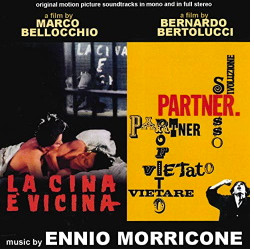LA CINA È VICINA (1967)
La Cina è Vicina is a drama film, and is the second and final film Morricone scored for director Marco Bellocchio after I Pugni in Tasca in 1965. It is a satirical movie about the struggle for political and social power, and stars Glauco Mauri, Elda Tattoli, and Pierluigi Aprà as as three siblings of the Gordini-Malvezzi family, wealthy aristocrats from northern Italy. Vittorio, a university professor, wants to launch a political career, but is constantly undermined by those around him, who take advantage of his meek personality. Elena is dissatisfied with her life, and embarks on numerous sexual escapades with working class men, but never gets close because she fears they only love her for her money. Camillo, the youngest, is training to be a priest, but is being swayed from his calling by socialist politics. Things come to a head via a young and ambitious Carlo, a local man who manipulated all three siblings for his own personal and professional needs.
Morricone’s score for La Cina è Vicina is ironic and sardonic, using unusually phrased marches and variations on a pompous main theme to comment on the social and political machinations inflicted on the family by the duplicitous Carlo. The main theme, “La Cina è Vicina,” is a bulbous piece for throbbing drums, pseudo-militaristic muted brass, and an oddly-timed tinkling harpsichord, which occasionally switches places with a, comedic dance that ripples around the orchestra almost like mickey mouse music, and little interludes of soft and gentle classical music that illustrate the genteel surroundings of the Gordini-Malvezzi family villa. Several variations of the theme offer interesting commentary; “#2” is aggressive and shrill, with more prominent metallic percussion and laughing bassoons; “#5” focuses on dainty and flighty flutes, little pizzicato textures, and frothy classical dance rhythms; “#6” features a more wholesome-sounding accordion “#13” arranges the piece for a funereal church organ; and so on.
There are also several performances of the theme “Ninna Nanna 1968,” which uses honking woodwinds to cut through a delicate, enigmatic string and harp the theme, like a stain on silk, and later arranges the same melody like a music box. The unusual juxtaposition of these lovely, pretty themes against a series of broken, agitated strings, harsh pianos, and irritating woodwinds, clearly represents the notion of the family’s idyllic life being constantly undermined by the toxic presence of Carlo, and is very clever.
The score for La Cina è Vicina has been released a couple of times over the years, but the best release is probably the one by GDM Music from 2012, a limited edition CD which pairs just under 30 minutes of music from the film with three cues from the 1968 film Partner.
Track Listing: 1. La Cina è Vicina (2:41), 2. Ninna Nanna 1968 (1:42), 3. La Cina è Vicina #2 (1:28), 4. La Cina è Vicina #3 (1:10), 5. La Cina è Vicina #4 (1:44), 6. La Cina è Vicina #5 (1:52), 7. La Cina è Vicina #6 (1:29), 8. La Cina è Vicina #7 (1:26), 9. La Cina è Vicina #8 (2:11), 10. La Cina è Vicina #9 (1:13), 11. La Cina è Vicina #10 (1:36), 12. La Cina è Vicina #11 (0:49), 13. Ninna Nanna 1968 #2 (1:40), 14. La Cina è Vicina #12 (3:00), 15. La Cina è Vicina #13 (1:33), 16. La Cina è Vicina #14 (1:02), 17. Ninna Nanna 1968 #3 (1:53). GDM Music 4160, 28 minutes 29 seconds.












